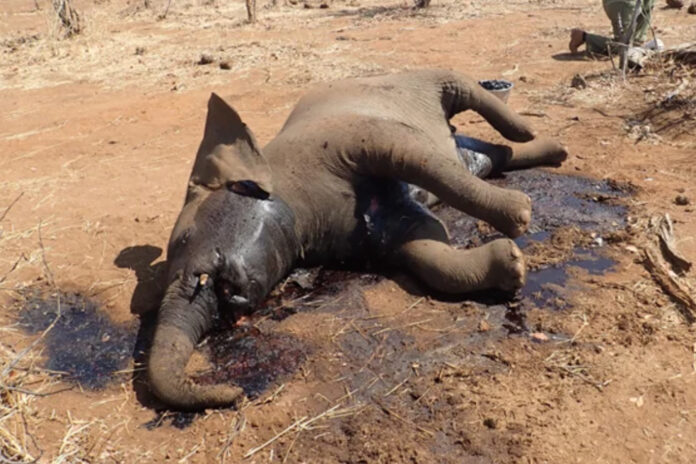The mystery of why hundreds of endangered African elephants have been dropping dead may have been solved by scientists.
Thirty-four elephants were found dead in northwestern Zimbabwe between August 24 and September 20, 2020, with another single elephant found dead in November 2020. Only a few months earlier, around 350 elephants were found dead in Botswana’s Okavango Delta.
Now, the cause of death for six of the Zimbabwe elephants has been revealed to be a bacterium named Bisgaard taxon 45, an unclassified member of the Pasteurellaceae bacterial family that has not been previously known to kill elephants, according to a paper in the journal Nature Communications.
Before this discovery, other causes of death being investigated were deliberate cyanide poisoning, anthrax and poaching.
This bacterium was found during a postmortem of the six elephants, which revealed that the gentle giants had died from septicemia, or blood poisoning, caused by Bisgaard taxon 45. Elephant necropsies are no easy feat, as they must be performed within hours of death before the intense heat starts to break down the animal’s tissues to the point where the cause of death cannot be determined.
“Investigating this mortality in the wildlife areas in northwest Zimbabwe proved challenging. Identifying and then reaching the carcasses in time to obtain useful samples is one problem we often face in this type of work,” lead investigator Chris Foggin, a wildlife veterinarian at the Victoria Falls Wildlife Trust, said in a statement.
He went on: “However, we also didn’t know what disease we may be dealing with, although we initially suspected that it could be anthrax, which is known to occur in the area, or possibly some other disease that might pose a risk to human health. We therefore had to be cautious when undertaking the postmortem examinations on elephants, which, in itself, is a difficult task with such a big animal, especially working in field conditions.”
The scientists suggest that the drought conditions at the time, as well as intense heat and limited food and water resources, likely contributed to the deaths of these elephants from the bacterial infection but would not have resulted in their deaths without the presence of tBisgaard taxon 45.
“Although there was no culture or molecular evidence to confirm Bisgaard taxon 45 in more than six mortalities in Zimbabwe, the elephants examined were in good body condition and unlikely to have died of drought-related starvation or severe dehydration alone,” they wrote in the paper.
The exact way that this bacterium was spread among the elephants is still unclear, but the authors suggest that it may have entered the elephants’ bloodstreams due to the intense heat, in a similar manner to how other species of Pasteurella bacteria have caused deaths in other animals. Pasteurella bacteria have been found to live harmlessly on the tonsils of antelopes, as well as in tigers, lions and chipmunks, and are thought to have killed more than 200,000 saiga antelopes in Kazakhstan in 2015 by entering the bloodstream in a similar manner.
Foggin, C.M., Rosen, L.E., Henton, M.M. et al. Pasteurella sp. associated with fatal septicaemia in six African elephants. Nat Commun 14, 6398 2023.
“The identification of this bacterium is a significant step forward in learning more about why these elephants died, said Falko Steinbach, head of virology at the U.K.’s Animal and Plant Health Agency, in the statement.
He continued: “Transmission of the bacteria is possible, especially given the highly sociable nature of elephants and the link between this infection and the stress associated with extreme weather events such as drought, which may make outbreaks more likely.
“Further research is needed to learn more about the bacteria and its long-term implications for the African elephant population and other wildlife,” Steinbach said.
Whether Bisgaard taxon 45 was also responsible for the deaths of the 350 elephants in Botswana unclear.
“While the mortalities in Botswana have been attributed to cyanobacterial neurotoxins, further details have not been published,” the authors wrote in the paper.
No cyanobacteria toxins were found in the Zimbabwe elephants, however.
African elephants are listed as endangered on the International Union for Conservation of Nature’s Red List of Threatened Species, and are in decline at a rate of 8 percent every year, primarily because of poaching. The remaining population of elephants is now only around 350,000, having dropped by over 140,000 from 2007 to 2014.
Scientists are concerned that Bisgaard taxon 45 and other bacterial infections may pose another threat to these remaining elephants, especially in the face of a warming climate.
“The international composition of our research team highlights the opportunities arising for conservation investigations into the disease and death of free-ranging animals,” said Arnoud van Vliet, a senior lecturer in veterinary microbiology at the University of Surrey’s School of Veterinary Medicine, in the statement.
“Bisgaard taxon 45 has never before been associated with bacterial septicemia and it adds to the growing list of disease-related threats to elephant conservation,” he said.
Do you have an animal or nature story to share with Newsweek? Do you have a question about elephants? Let us know via [email protected].
Uncommon Knowledge
Newsweek is committed to challenging conventional wisdom and finding connections in the search for common ground.
Newsweek is committed to challenging conventional wisdom and finding connections in the search for common ground.


